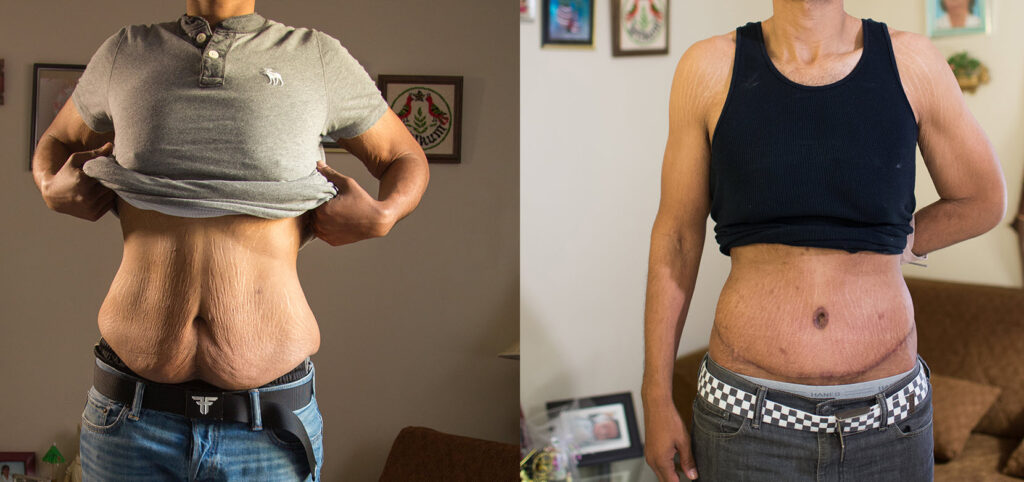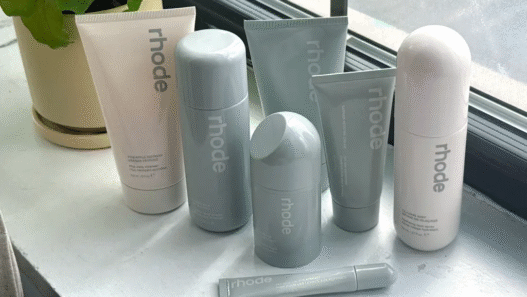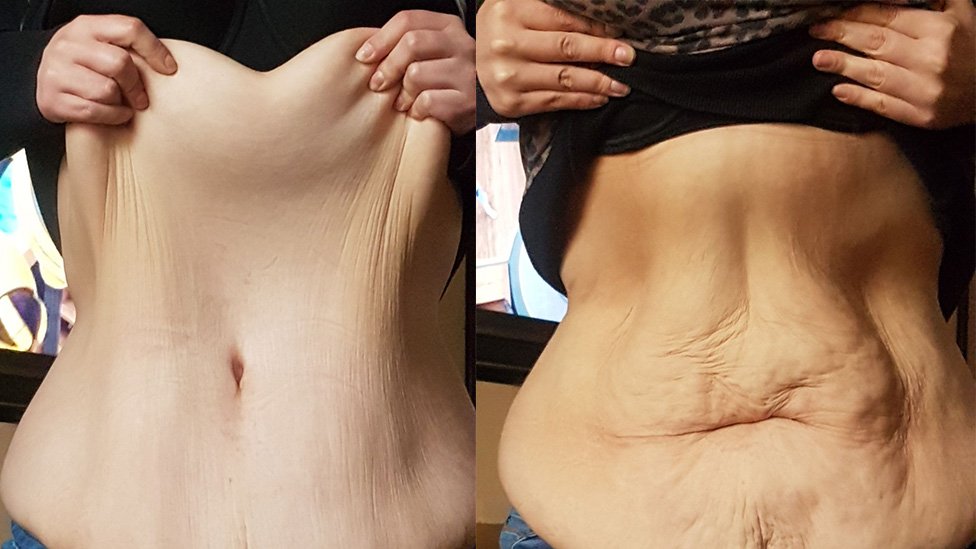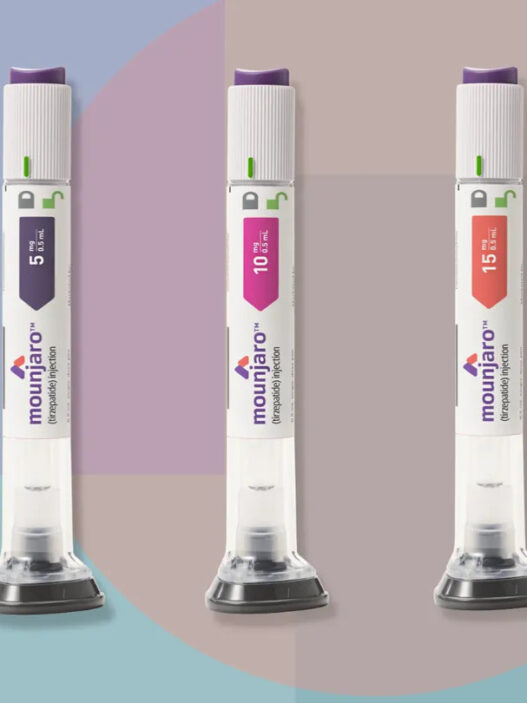As the body transforms and it faces many changes, loose skin after weight loss becomes a common part of weight loss journey. It affects your self-esteem, boosts your confidence and reminds you of the progress you’ve made.
Introduction
Skin is the largest organ of the body, and one of its most resilient organs. As we grow up, our skin grows with us, and it can expand to accommodate added weight.
But once it expands, it does not necessarily go back to its original smooth, tight state on its own after that extra weight is gone. And that’s OK..!!

If you have loose skin after weight loss, it is OK too…!!
Losing weight affects your health for the better in different ways. But there are other steps you can take to improve your skin’s tone and tightness after significant weight loss.
What Causes Loose Skin After Weight Loss
To understand the cause of saggy skin after losing weight, it’s essential to learn how skin is structured and how it actually works. So basically, skin has three basic layers, which all perform important jobs to keep your body healthy.
Layers Of Skin
The top layer (epidermis) is the layer that’s visible.
It has following characteristics
- It provides protection
- Makes new skin cells
- Provides skin color or pigment.
Just beneath the epidermis is the middle layer, or dermis.
They have following characteristics:
- It makes collagen and elastin in the body to keep the skin strong and stretchy that contribute to the smoothness or sagginess of skin.
The name of the bottom layer is hypodermis. This layer contains fat, connective tissue, and more nerves and blood vessels. It helps as cushion for the top two layers and works to protect the rest of the body. Hypodermis has ability to store fat that performs functions when you gain or lose weight.
Skin elasticity
Elasticity of skin is defined as what allows for your organs to expand under the skin when you gain a lot of weight, build up your muscle mass, or are pregnant. The elastin and collagen found in the dermis give skin this give-and-take quality.
Like elastic bands, elastic fibers,that are made up of elastin in the skin,and make it able to be flexible and stretchable.
Do you know what is collagen?
Collagen is a protein that provides structure, support, and strength to skin and other organs. As you become aged, your body produces less of this essential protein, which results in saginess of the skin.
The fat found inside the hypodermis causes the skin to expand during weight gain. Some subcutaneous, or “subQ” ( which means underneath the skin) fat is necessary for a healthy body. It provides that much-needed cushion for bones and muscles.
But the amount of your subcutaneous fat can increase to unhealthy levels, depending on your diet, lifestyle, or other health issues, such as diabetes,heart issues, obesity etc.
As this subQ fat increases, your skin stretches to make space for it. Like the resilient rubber band , if the skin is stretched far enough for long time, it won’t snap back into its original shape which may lead to loose or saggy skin.
How Much Weight Loss Causes Loose Skin?
Loose Skin? Really??
Yes!!!
Loose skin can be caused by a number of factors , including:
- How quickly weight is lost
- The percentage of total body weight lost
- How long you’ve been at your starting weight
- Genetics
- Age
So it’s simple to see how a substantial weight loss of 100 or more pounds can cause your skin to be loose. But even a person who appears thin or athletic can have loose skin due to weight loss, but a person with good physique have no loose skin.
Loose Skin Problems
For many people, saggy skin or stretch marks (which are caused by rapid weight gain, such as during pregnancy) are just a part of life. But there are times when excessive skin on your body can cause physical or emotional discomfort and even lead to serious health issues.
Hygiene Issues
Saggy skin may form folds that snare moisture, sweat, and bacteria. That’s why health care experts recommend washing your skin between the folds with pH-balanced liquid soap, cleanser, or disposable wipes before gently patting skin dry.
Other things that can help you stay dry include staying away from tight clothing or wearing items made from fabrics that are quick-drying or wick away sweat.
Loose Skin Rash
If moisture continues to collect within folds of skin, the skin can rub together and cause a condition called intertrigo. (In babies, it’s known as diaper rash.)
This red or brownish red rash is more common in hot, humid climates and during the summer months and can cause itching and stinging.
In the early stages, you can take steps to keep skin dry and apply a chafing powder or gel. If left untreated, this rash can lead to an infection.
Yeast Infection
Although common and typically not serious, yeast infections, or candidiasis, are another reason for giving saggy skin folds some extra love.

This overgrowth of fungi can cause discomfort, including redness, itchiness, and burning. If left untreated, the infection can be worsen, and you would need to talk with your dermatologist. Again, keeping skin dry within skin folds is the key to prevention.
Body Image And Mental Health
Despite loosing weight, loose skin may become an issue that affects your body image, as well as your mental and physical well-being. Loose skin may be an alarm of when you had overweight or obesity.
You may feel so self-conscious that you withdraw yourself from social activities or feel anxious or depressed due to being overweight.
How to Tighten Loose Skin After Weight Loss
To tighten skin after weight loss, build muscles with strength training, eat a diet which is protein rich , and stay hydrated which supports the skin’s health.
Non-surgical options like radiofrequency and collagen-boosting treatments can also help in firming loose skin. If these methods don’t give you the consequences you want, surgical procedures may be an option too.
Exercise
Staying active with both muscle training and cardio can help tightening and toning your skin over time. Exercise builds muscle to fill out loose skin and boosts circulation throughout the body which improves skin elasticity and overall appearance.
Building lean muscle
It can help in filling out loose skin. Muscle also boosts your metabolism, helping you burn more calories even if you’re at rest.
Increasing circulation
It delivers oxygen and nutrients to the skin to support collagen production, elasticity, and overall skin health.
Promoting skin hydration
It may give skin a plumper, firmer look. However, hydration alone won’t tighten loose skin.
Guide For Exercise
- 150 minutes of moderate cardio, such as brisk walking,treadmill, elliptical,swimming etc.
- Two days a week of activities that strengthen muscles
Optimize Your Diet
Another way to improve loose skin is your diet. Talk to your dietitian about adding the adequate ingredients to your meals.
I’m giving you the list of the ingredients you can add to your meals
- Salmon, tuna, walnuts, almonds, and edamame
- Citrus fruit, peppers, strawberries, broccoli
- Meat, fish, eggs
- Beans, tofu, and nuts
- Drink plenty of water to keep your skin hydrated
Consider Non-Surgical Treatments
It is a way of tightening loose skin without surgery, considering these non-invasive and minimally invasive treatments.
Ultherapy
This technology uses ultrasound energy for boosting collagen production and lifting saggy skin on the face, neck, and chest.
Radiofrequency (RF) Therapy
Heats the skin to stimulate collagen and elastin, improving firmness and elasticity.
Vacuum-assisted Massage
It uses suction to increase circulation and remodel collagen, helping skin look smoother and more toned.
Laser Resurfacing
This technique heats deep layers of skin which trigger collagen production without harming the surface, effectively tightening areas like the belly and upper arms over time.
These treatments work best for mild to moderate skin type and often require multiple sessions for noticeable results that loose your pocket too…
Aim For Gradual Weight Loss
Losing weight slowlt about 0.5 to 1kg per week helps prevent loose skin because it gives your skin time to shrink as your body gets smaller. It also helps you keep muscle, which supports your skin and keeps it firm.
If you lose weight fastly, like after bariatric weight loss surgery, your skin might not be able to keep up and may loose. How long you were overweight, your age, and your genetics also affect how well your skin bounces back.

In addition to losing elastin and collagen, after excessive weight loss, the makeup of the collagen left in your skin changes also changes. In fact, after losing weight, your skin contains less collagen. This results in its composition changing.
Factors That Influence Loose Skin
The makeup of your skin is also determined by other factors that include
- Your age
- History of smoking
- General health
- Family history and genetic make-up
- Eating a balanced diet
Summary
Loose skin after weight loss after a significant weight loss is common and often doesn’t require any treatment.
If you have any loose skin problems that is a lot of chafing and discomfort or are frustrated by it, there are several treatment options, that ranges from diet and exercise to non-invasive procedures like laser resurfacing. Surgical tightening can also be an option for some people.
To determine which treatment is right for you, talk with your healthcare provider.

















